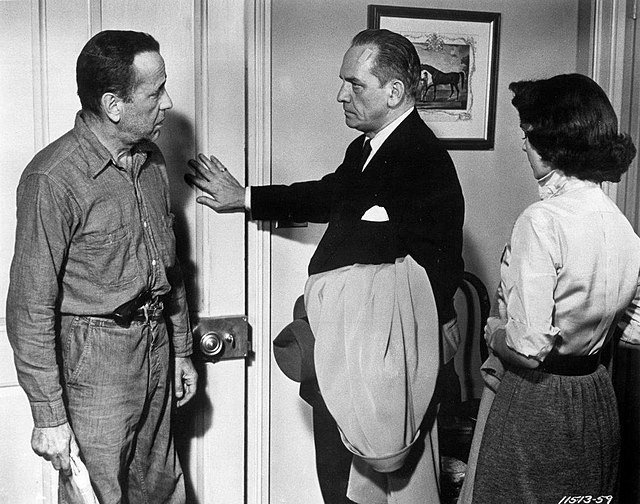
The desperate hours (V.O. The desperate hours)
USA, 1955
Director: William Wyler
Screenwriter: Joseph Hayes (based on his novel and play)
Genre: Film noir, thriller, drama
Soundtrack composer: Hugo Friedhofer
Editor: Robert Swink
Production company: William Wyler (producer), William Wyler Productions
Main actors:
Humphrey Bogart (Glenn Griffin)
Fredric March (Daniel Hilliard)
Arthur Kennedy (Sam Kobish)
Martha Scott (Nettie Hilliard)
Dewey Martin (Hal Griffin)
Gig Young (Carl Potter)
Mary Murphy (Cindy Hilliard)
Richard Eyer (Ralph Hilliard)
Walter Baldwin (George Patterson)
Plot
The Hilliards are an upper middle-class family living in a house in suburban Indianapolis. It consists of father Daniel, mother Ellie, eldest daughter Cindy and young son Ralphy. The Hilliards lead a placid and harmonious life. But that is about to change…
Three dangerous criminals have escaped from prison: Glenn Griffin, his younger brother Hal and the particularly bestial Sam Kobish. After going on the run, they look for a house in the surrounding area where they can hide and, unsurprisingly, they choose the Hilliard’s house.
The trio of fugitives take the family hostage. Glenn makes a call to his girlfriend, who is supposed to bring them money and a different car from another state to continue the escape. Supposedly, the woman will arrive around midnight and the criminals will leave with her and leave the family alone.
For their part, the police have lost track of the escapees. It is as if they had been swallowed up by the earth. The sheriff then has the happy idea of keeping a close eye on Glenn’s girlfriend, hoping that she will lead them to the three bandits. But everything gets complicated when the young woman is stopped by the police of the other state for speeding…
This will prolong the family’s ordeal, as they will continue to be held hostage for many more “desperate hours”…
Comment
Very good classic film noir that masterfully combines family drama with tension and suspense. Every scene is brimming with intrigue (especially as the climax approaches) and the performances of the entire cast are highly accomplished. Especially brilliant in his role is Humphrey Bogart as the leader of the escaped prisoners.
One detail to note is the father-son relationship we see throughout the film between Mr. Hilliard and the small but audacious Ralphy (who already feels grown up and wants to be called Ralph). The boy, who is of a very brave nature, looks to his father for an example to follow; and is somewhat disappointed that his progenitor does not directly confront the bandits from the very beginning. Mr. Hilliard wants to maintain caution so that no member of the family is harmed. But in his inner self, at the same time, his son’s expectations push him to somehow take the initiative to actively defend his own. This internal conflict, in the context of the relationship between the characters, is portrayed with great skill by both the screenwriter and the actors.
The dynamic between the three criminals is also interesting. Glenn (Bogart) is undisputedly the boss, but sometimes it is not easy for him to control the brutal and volatile Kobish (who, besides being unscrupulous, is not very bright either, and can therefore be unpredictable) and his younger brother Hal, the least bad of the three, who is attracted to the attractive Cindy (the daughter of the hostage family). The girl, by the way, has a boyfriend who works for the police. And who, still unsuspecting, insists on the phone to come and visit her – while the bandits are still there….
In many aspects of plot and approach, the film is reminiscent of a sub-genre of “exploitation” that decades later would become quite popular in Italy: that of escaped criminals who take innocent people hostage; as for example in “La casa sperduta nel parco” (Ruggero Deodato, 1980). But in the thriller we are discussing today, the violence is not as graphic as in later Italian productions, as more emphasis is placed on psychological tension and the characters’ character is explored in greater depth.
Regarding the topic, there are also similarities with “In Cold Blood” (Richard Brooks, 1967), the adaptation of Truman Capote’s novel of the same name, which is also based on real events. In that film, fugitives also take an entire family hostage.
In 1990, a remake was made, also titled “Desperate Hours” and directed by Michael Cimino.
Get The Desperate Hours HERE!
(This is an affiliate link. I may earn a commission if you purchase through these link, at no extra cost to you. As an Amazon Associate, I earn from qualifying purchases.)
